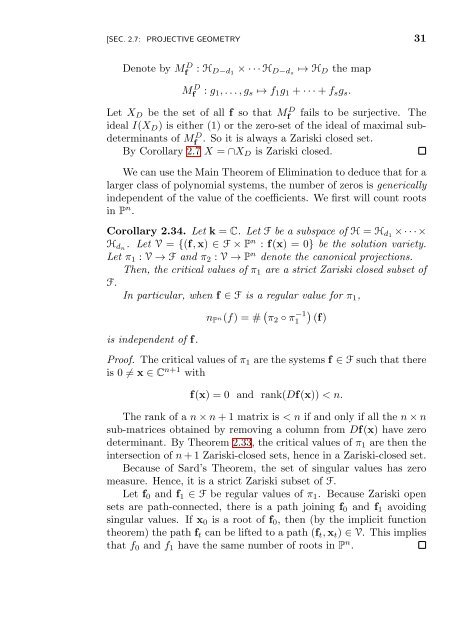Nonlinear Equations - UFRJ
Nonlinear Equations - UFRJ
Nonlinear Equations - UFRJ
Create successful ePaper yourself
Turn your PDF publications into a flip-book with our unique Google optimized e-Paper software.
[SEC. 2.7: PROJECTIVE GEOMETRY 31<br />
Denote by M D f<br />
: H D−d1 × · · · H D−ds ↦→ H D the map<br />
M D f : g 1 , . . . , g s ↦→ f 1 g 1 + · · · + f s g s .<br />
Let X D be the set of all f so that Mf<br />
D fails to be surjective. The<br />
ideal I(X D ) is either (1) or the zero-set of the ideal of maximal subdeterminants<br />
of Mf<br />
D . So it is always a Zariski closed set.<br />
By Corollary 2.7 X = ∩X D is Zariski closed.<br />
We can use the Main Theorem of Elimination to deduce that for a<br />
larger class of polynomial systems, the number of zeros is generically<br />
independent of the value of the coefficients. We first will count roots<br />
in P n .<br />
Corollary 2.34. Let k = C. Let F be a subspace of H = H d1 × · · · ×<br />
H dn . Let V = {(f, x) ∈ F × P n : f(x) = 0} be the solution variety.<br />
Let π 1 : V → F and π 2 : V → P n denote the canonical projections.<br />
Then, the critical values of π 1 are a strict Zariski closed subset of<br />
F.<br />
In particular, when f ∈ F is a regular value for π 1 ,<br />
is independent of f.<br />
n P n(f) = # ( π 2 ◦ π −1<br />
1<br />
)<br />
(f)<br />
Proof. The critical values of π 1 are the systems f ∈ F such that there<br />
is 0 ≠ x ∈ C n+1 with<br />
f(x) = 0 and rank(Df(x)) < n.<br />
The rank of a n × n + 1 matrix is < n if and only if all the n × n<br />
sub-matrices obtained by removing a column from Df(x) have zero<br />
determinant. By Theorem 2.33, the critical values of π 1 are then the<br />
intersection of n + 1 Zariski-closed sets, hence in a Zariski-closed set.<br />
Because of Sard’s Theorem, the set of singular values has zero<br />
measure. Hence, it is a strict Zariski subset of F.<br />
Let f 0 and f 1 ∈ F be regular values of π 1 . Because Zariski open<br />
sets are path-connected, there is a path joining f 0 and f 1 avoiding<br />
singular values. If x 0 is a root of f 0 , then (by the implicit function<br />
theorem) the path f t can be lifted to a path (f t , x t ) ∈ V. This implies<br />
that f 0 and f 1 have the same number of roots in P n .

















